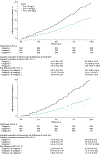Association of Albuminuria With Chronic Kidney Disease Progression in Persons With Chronic Kidney Disease and Normoalbuminuria : A Cohort Study
- PMID: 38560911
- PMCID: PMC12124184
- DOI: 10.7326/M23-2814
Association of Albuminuria With Chronic Kidney Disease Progression in Persons With Chronic Kidney Disease and Normoalbuminuria : A Cohort Study
Abstract
Background: Albuminuria is a major risk factor for chronic kidney disease (CKD) progression, especially when categorized as moderate (30 to 300 mg/g) or severe (>300 mg/g). However, there are limited data on the prognostic value of albuminuria within the normoalbuminuric range (<30 mg/g) in persons with CKD.
Objective: To estimate the increase in the cumulative incidence of CKD progression with greater baseline levels of albuminuria among persons with CKD who had normoalbuminuria (<30 mg/g).
Design: Multicenter prospective cohort study.
Setting: 7 U.S. clinical centers.
Participants: 1629 participants meeting criteria from the CRIC (Chronic Renal Insufficiency Cohort) study with CKD (estimated glomerular filtration rate [eGFR], 20 to 70 mL/min/1.73 m2) and urine albumin-creatinine ratio (UACR) less than 30 mg/g.
Measurements: Baseline spot urine albumin divided by spot urine creatinine to calculate UACR as the exposure variable. The 10-year adjusted cumulative incidences of CKD progression (composite of 50% eGFR decline or kidney failure [dialysis or kidney transplantation]) from confounder adjusted survival curves using the G-formula.
Results: Over a median follow-up of 9.8 years, 182 of 1629 participants experienced CKD progression. The 10-year adjusted cumulative incidences of CKD progression were 8.7% (95% CI, 5.9% to 11.6%), 11.5% (CI, 8.8% to 14.3%), and 19.5% (CI, 15.4% to 23.5%) for UACR levels of 0 to less than 5 mg/g, 5 to less than 15 mg/g, and 15 mg/g or more, respectively. Comparing persons with UACR 15 mg/g or more to those with UACR 5 to less than 15 mg/g and 0 to less than 5 mg/g, the absolute risk differences were 7.9% (CI, 3.0% to 12.7%) and 10.7% (CI, 5.8% to 15.6%), respectively. The 10-year adjusted cumulative incidence increased linearly based on baseline UACR levels.
Limitation: UACR was measured once.
Conclusion: Persons with CKD and normoalbuminuria (<30 mg/g) had excess risk for CKD progression, which increased in a linear fashion with higher levels of albuminuria.
Primary funding source: None.
Conflict of interest statement
Figures


References
Publication types
MeSH terms
Substances
Grants and funding
LinkOut - more resources
Full Text Sources
Medical
Research Materials
Miscellaneous
